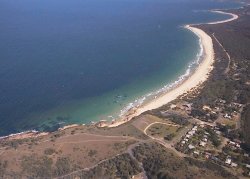Moruya
|
Moruya New South Wales |
|
|---|---|

Dolphin Beach, Moruya South Head
|
|
| Coordinates | 35°54′40″S 150°04′50″E / 35.91111°S 150.08056°ECoordinates: 35°54′40″S 150°04′50″E / 35.91111°S 150.08056°E |
| Population | 2,531 (2011 census) |
| Established | 1851 |
| Postcode(s) | 2537 |
| Location |
|
| LGA(s) | Eurobodalla Shire |
| State electorate(s) | Bega |
| Federal Division(s) | Gilmore |
Moruya is a town in New South Wales, Australia, situated on the Moruya River, on the far south coast situated on the Princes Highway 305 kilometres (190 mi) south of Sydney and 175 kilometres (109 mi) from Canberra. At the 2011 census, Moruya had a population of 2,531 people. The town relies predominantly on agriculture, aquaculture, and tourism. Moruya is administered by the Eurobodalla Shire council and the shire chambers are located in the town.
The name Moruya is derived from an Aboriginal word, (phonetically) mherroyah, meaning "home of the black swan". Black swans can still be seen in the lakes and rivers around Moruya, and the black swan is used locally as an emblem (nationally, the black swan is known as an emblem of Western Australia).
The area is the traditional home of two tribes: the Walbanga and the Brinja-Yuin. European settlement commenced in the 1820s following the extension of the limits of location in 1829. The coast from Batemans Bay to Mherroyah was surveyed in 1828 by Surveyor Thomas Florance. The first European settler was Francis Flanagan from Ireland who settled at Shannon View in 1829. John Hawdon from England established a property named Kiora in 1831 and a village named after the property grew.
The town centre was surveyed in 1850 and the town gazetted in 1851. Moruya was proclaimed a municipality in 1891. Local industries were timber getting, gold mining, dairying and quarrying for granite. The granite for the Sydney Harbour Bridge pylons was quarried in the area.
Quarrying for granite commenced in the district in the late 1850s by the brothers Joseph and John Flett Loutitt who were from the Orkney Islands. Their quarry on the south side of the river produced stone for many Sydney landmarks including the pillars of the General Post office in Martin Place, and the base of the Captain Cook statue in Hyde Park.
...
Wikipedia

